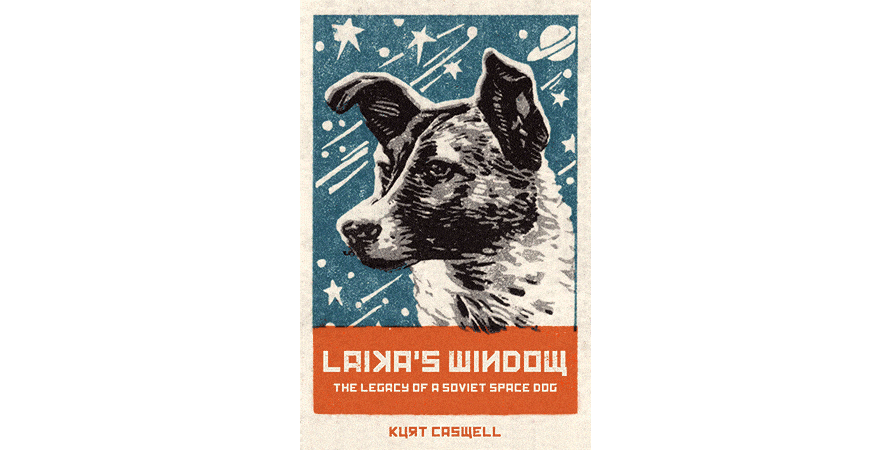Category: Nonfiction
Reviewed by Clifford R. McMurray
Title: Laika’s Window: The Legacy of a Soviet Space Dog
Author: Kurt Caswell
NSS Amazon link for this book
Format: Hardcover, Kindle
Pages: 256
Publisher: Trinity University Press
Date: October 2018
Retail Price: $24.95/$9.99
ISBN: 978-1595348623
The story of the first living creature to orbit the Earth is a tragic one. When they launched her into space in Sputnik 2, Laika’s Soviet masters knew she wasn’t going to survive the trip. Her “mission” was hastily conceived and executed, with Cold War propaganda more in mind than science, and her life support capsule had no heat shield or parachute to make a safe return possible. Her fate was sealed from the moment her rocket left the launch pad. This central fact makes this book, good and faithful history as it is, not a happy read. But it’s worth reading anyway, because it offers a perspective most space history books can’t offer.
Almost all the books about space are written by people interested in space. Kurt Caswell, in contrast, comes to our story as an outsider. His prior writing has been about nature and humanity’s relationship with it. It won’t take the reader long to figure out that he’s more interested in Laika and her relationship with her masters that he is with the nuts and bolts of spaceflight. Still, he does a very good job of covering the early history of the space race and giving appropriately basic details of the technical aspects of rocketry and orbital mechanics that bear on this story, while talking about the things he’s more used to talking about. There’s something here for readers with a wide range of interests, from space history buffs to humanities majors. Caswell begins with a history of the use of animals as human surrogates in aviation and spaceflight, moves on to Laika’s selection and training, then to her flight, and concludes with his meditation on what it all means.
Use of animals as stand-ins for humans on experimental flights dates all the way back to 1783, when the Montgolfier brothers sent a sheep, a duck, and a rooster aloft in one of their first balloon flights. Animals have been our pathfinders ever since. The first living creatures to be lofted into space were fruit flies launched on a V-2 rocket from White Sands in 1947. In 1968 the first animals to fly around the Moon were a pair of tortoises in a Russian Zond capsule. Laika wasn’t the first dog in space, either. Between 1951 and 1956, the Russians had launched more than 50 dogs on suborbital flights. Americans preferred chimps and monkeys to dogs, and had their own sacrifices to progress. Although our animal test subjects always rode in capsules with parachute recovery systems, the parachutes didn’t always work. These animal flights, and the ones that followed Laika (often but not always to happier endings), are ably covered in the first part of the book.
Laika was a stray mutt scooped off the streets of Moscow and trained with other dogs as a canine cosmonaut. When Sputnik 1 captured the attention of the entire world, it caught the Soviets as much by surprise as it did the Americans. Soviet Premier Khrushchev asked the head of his space program, Sergei Korolev, if he could come up with a suitable encore in time for the 40th anniversary of the Russian revolution just a month later. The result was a hastily conceived and executed launch of Sputnik 2 with Laika aboard. Spaceflight was so new that heat shields hadn’t been perfected yet, so the only way Sputnik 2 would be coming back down was as an artificial meteor. Nevertheless, Korolev and his team hoped Laika would live for at least a day or two in space, to prove that humans could do likewise in a few years, after recovery systems could be perfected. Sadly, she died just a few hours after launch, when the failure of her capsule’s cooling system caused her to perish of heat exhaustion. The Soviet propaganda apparatus, taken aback at the widespread outrage from the news that she was never planned to come home, spread the fiction that she had been painlessly neutralized. The true story of her painful last hours wasn’t made public until many years later.
Laika’s flight became a symbol of Soviet technological prowess, and simultaneously a symbol of the heartless cruelty of the Soviet dictatorship. For Caswell, the question is how willing our animal partners are to lead the way. Laika had a small, six inch diameter window in her capsule. Was she able to see the Earth below her, and what did she think in her final hours? That’s not the kind of question a space geek would ask; it’s one of the reasons a space geek might want to read this book.
© 2021 Clifford R. McMurray
Please use the NSS Amazon Link for all your book and other purchases. It helps NSS and does not cost you a cent! Bookmark this link for ALL your Amazon shopping!



















